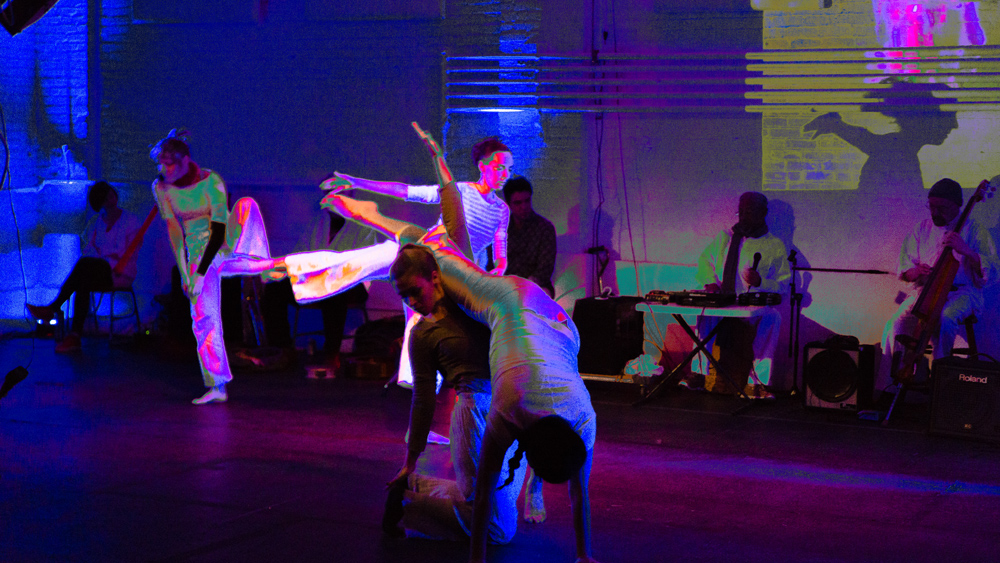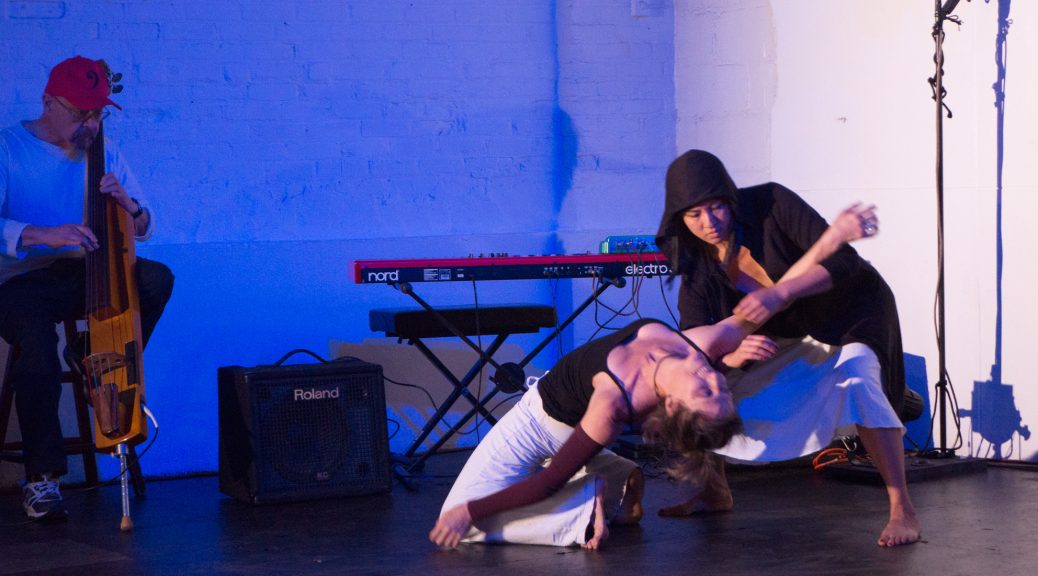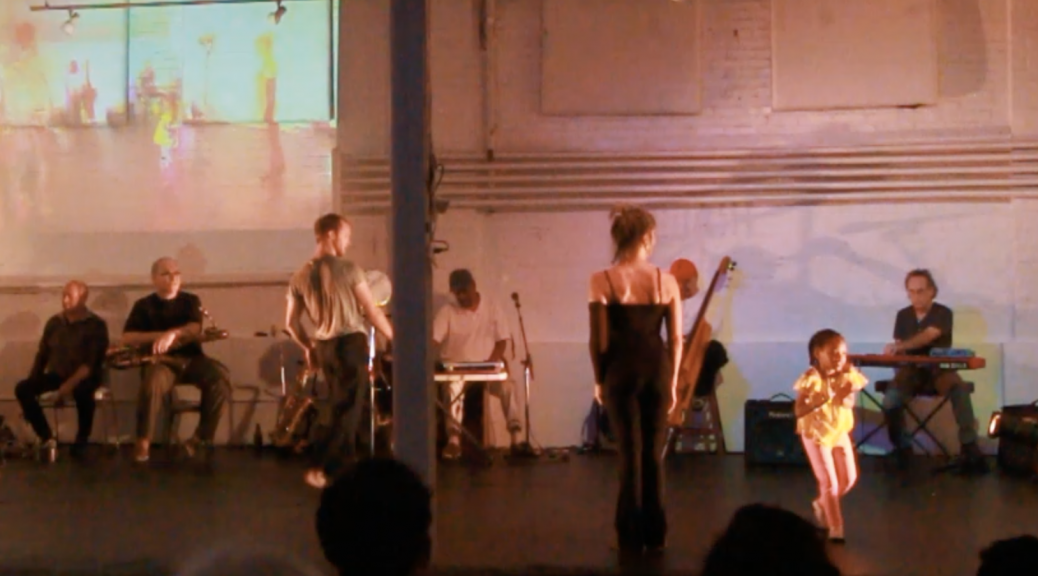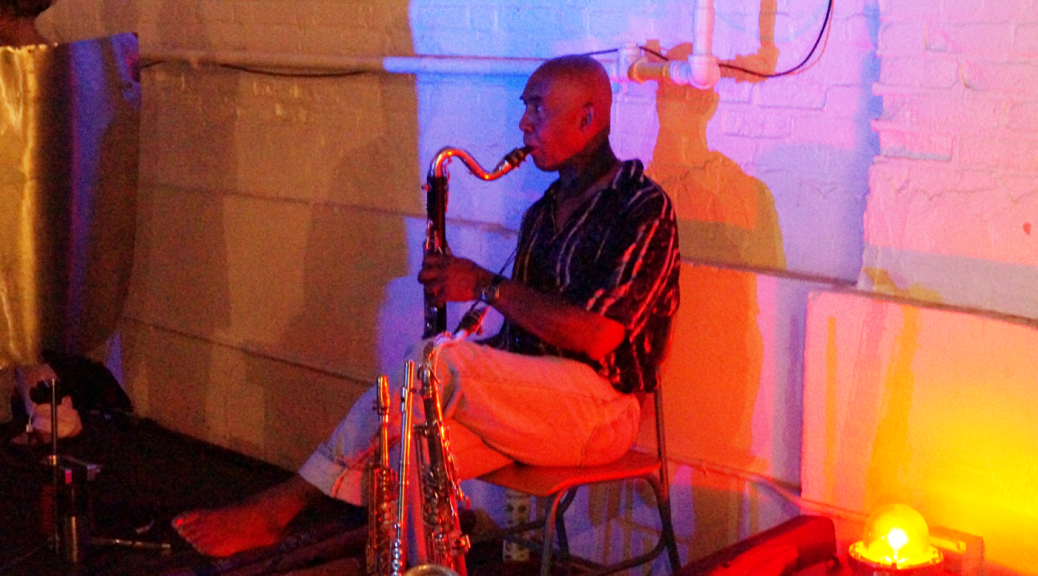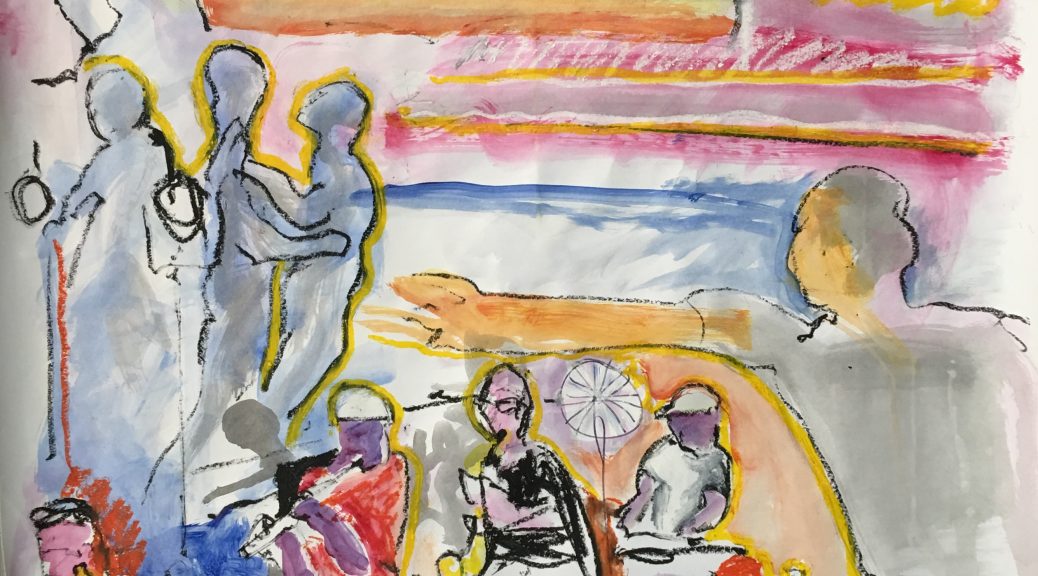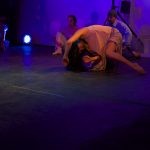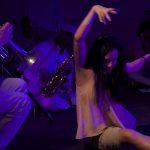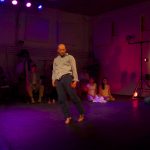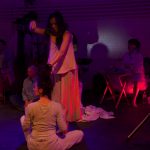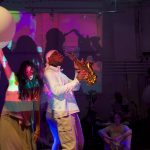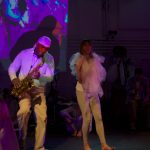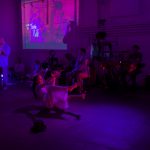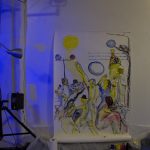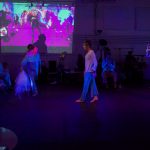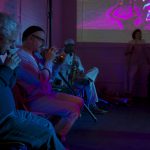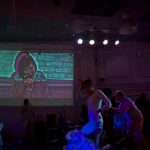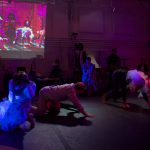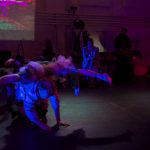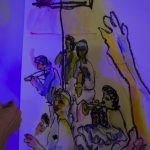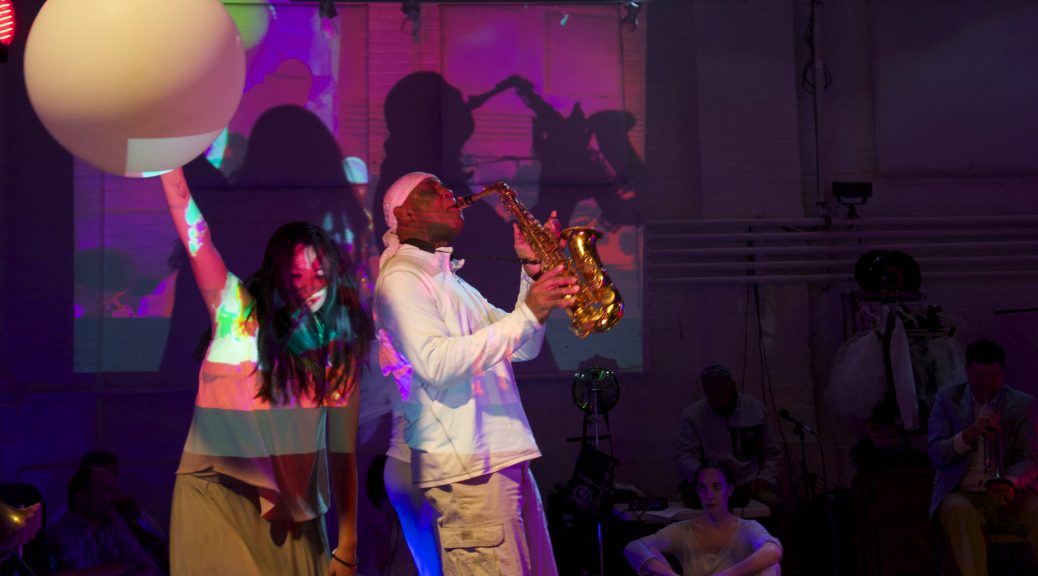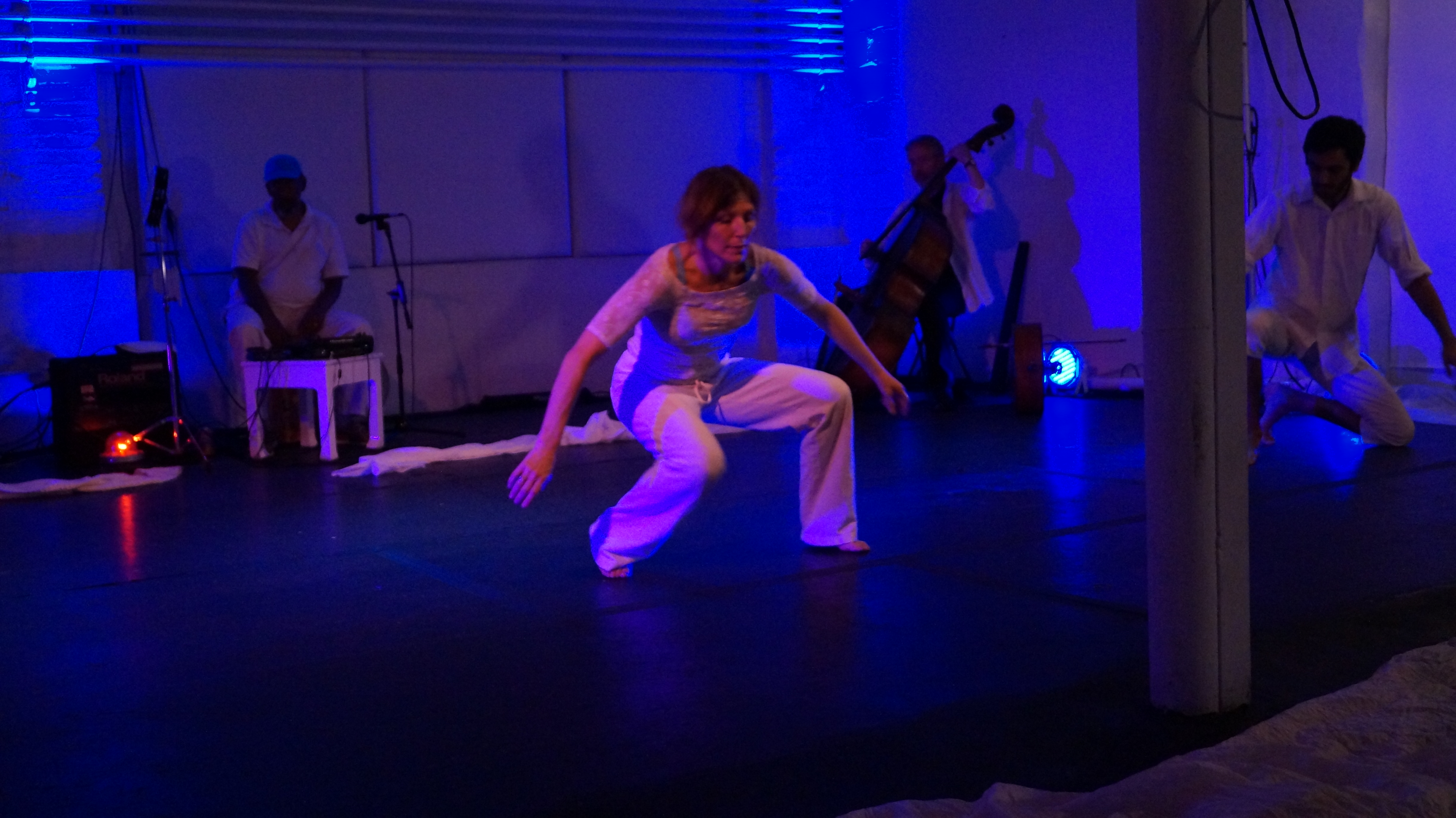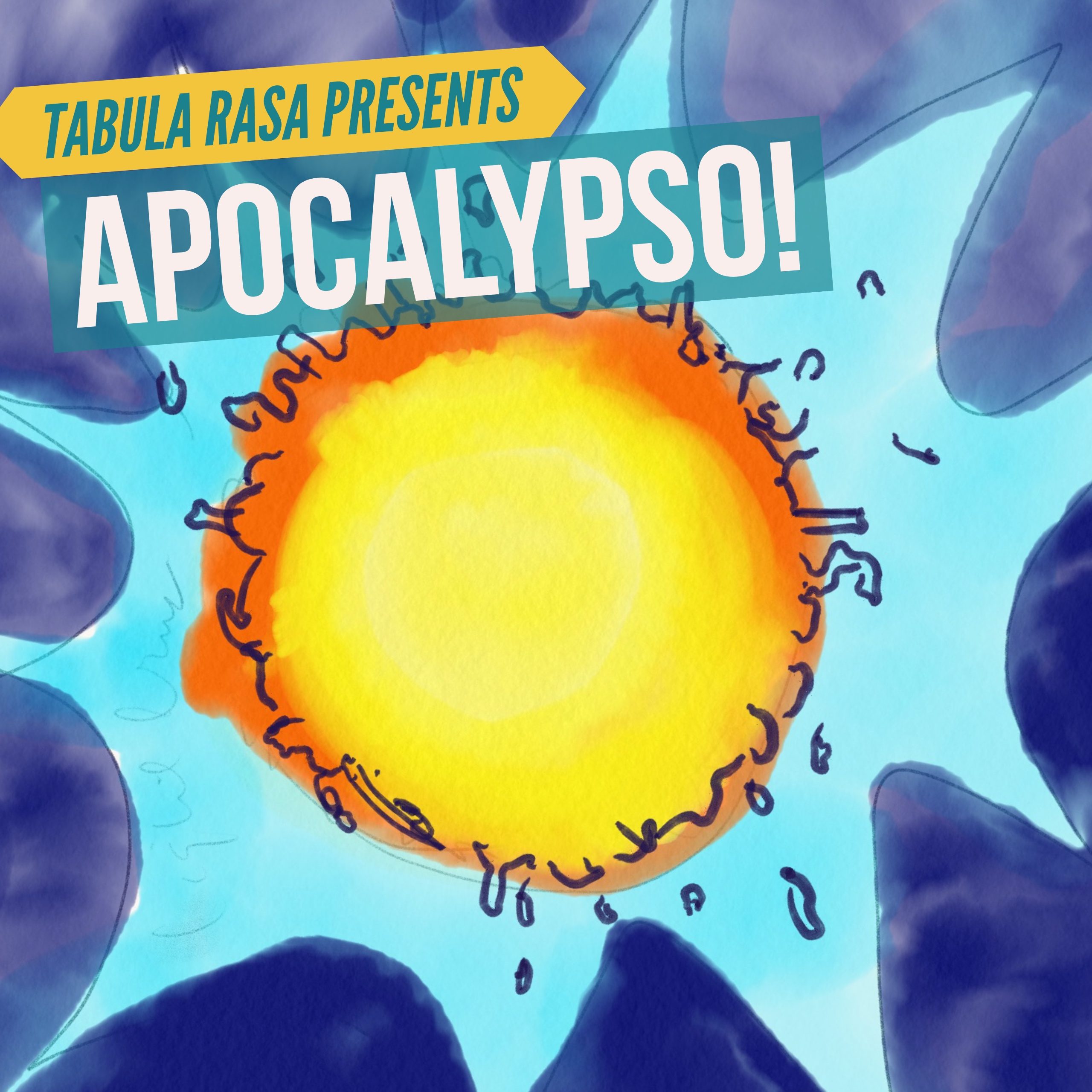Tabula Rasa answers a craving many artists have to cross-fertilize in an improvisational setting. The first part, from 6-8pm, is a video and art show, a retrospective of the past five years of staging this experiment. At 8pm the show begins, with seven old time jazz musicians, famous in the local scene, improvising while seven dancers also improvise, a painter paints live, a camera person’s live video is filtered and projected, in a stage-lit warehouse in the middle of Union Square, Somerville. In the second half, those from the audience like musicians (bring your instruments!), dancers, actors or performance artists of any kind are invited to join in the performance. Visual artists are invited to draw or paint at large tables at any time. Beer and wine will be served.
All posts by catemuse
HEADBONE – January 26th 2018
HeadBone happened! This was Tabula Rasa Multidisciplinary Experiment’s first retrospective art opening and performance.
Friday, January 26, 2018: We had our first Art and Video Retrospective Opening at 6pm. Preparing for it involved lots of sewing of cloth to paper, as Catherine innovated a scroll technique using cloth sleeves and dowels.
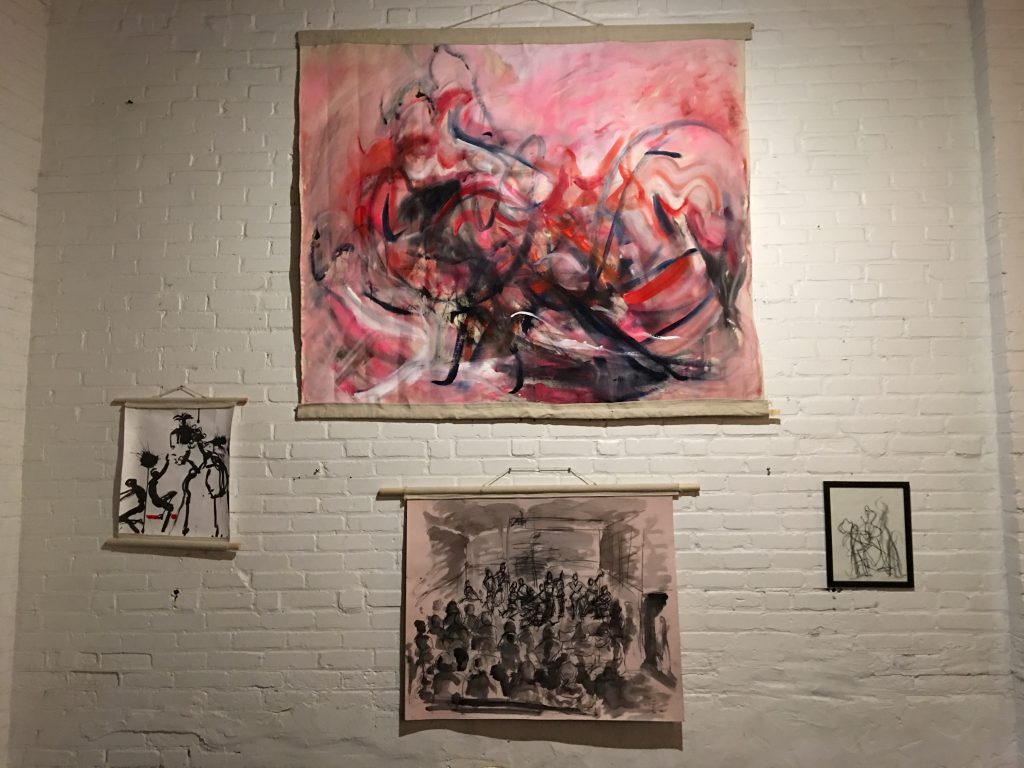
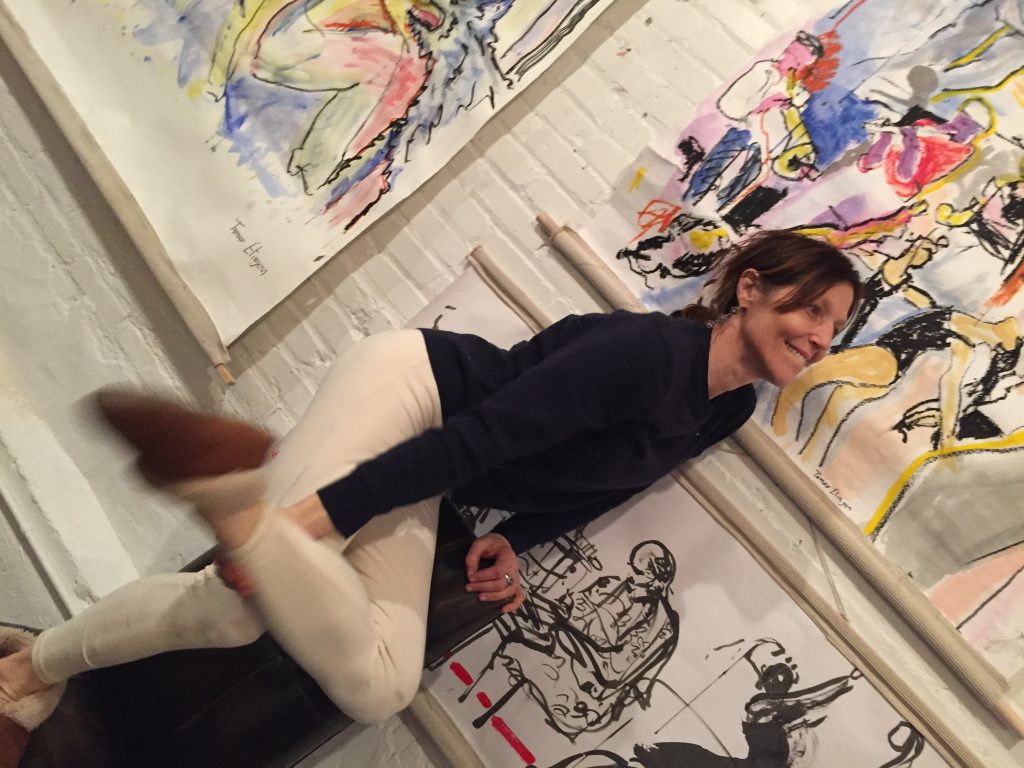
At 8pm the performance experiment began. The dancers had invented some new “structures” which we announced to the audience as we had in prior TR’s. Audience seemed to appreciate it, although some found the ideas a little mundane. That’s the thing about structures.. the stucture itself isn’t the poetry. It’s the cookie cutter, the wax mold for the sculpture that will result.
This time the musicians circled the space, creating surround sound for the audience. They created beautiful, evocative worlds despite being stuck in the dark the whole night. The dark- that was a mistake. They are all so gorgeous, no one would have wanted them to be invisible.
Karen Klein wove words that evoked a wet forest, or a puzzle the dancers fit into, seamlessly.
Musicians included Stan Strickland, John Voigt, Russ Gershon, Syd Smart, Scott Getchell and Josh Rosen;
Dancers included Lani Nahele, Carlie Silva, Natalie Eggert, Catherine Musinsky, Chien Hwe, Emily Jerant-Hendrikson and Sara June.
The painter: Tamar Etingen.
Poet: Karen Klein.
HeadBone 1.6.18 from Catherine Musinsky on Vimeo.
Here’s what happened after intermission, when members of the audience joined in:
Produced by Catherine Musinsky, as always (so far)
Where it took place:
WAREHOUSE XI
11 Sanborn Court
Somerville, MA
For more info on upcoming experiments or other work, text or call
Catherine at 617-223-7822
or email her at catemuse@gmail.com
THANK YOU, WAREHOUSE XI and SOMERVILLE ARTS COUNCIL!
Somerville Journal wrote about us
writes evocative stories for the Boston Globe and Somerville Journal. She happened to attend Thursday’s performance of ESCAPE, a Tabula Rasa Multidisciplinary Experiment, and called me later for an interview. Here is what she wrote:
Somerville artists create fully improvised performance |
Well-connected in the Boston creative circles, Musinsky assembled an accomplished crew of jazz musicians, many of whom are friends. Jazz musician and Musinsky’s neighbor Stan Strickland, who played saxophone on Thursday, opened for Aretha Franklin last year. Scott Getchell, who plays the trumpet, said that that improvising together is natural for Tabula Rasa’s musicians.
“It’s pure improvisation,” said Getchell. “But we’ve known each other for so long, that there are certain genres we can fall into.”
Throughout the performance, the motifs of blues, tango, and more classical music emerged. Musinsky compares dancing to live jazz as to being played like a marionette.
“We’re responding to the music and they’re responding to us,” she said.
To the side of the stage, Somerville artist Tamar Etingen was painting on a large poster. By intermission, the abstract strokes became figures of musicians and dancers.
“The musicians are playing, I’m painting–we’re all doing what we do,” said Etingen, who focuses on gelatin printmaking.
Joshua Rajman, who heard about ESCAPE from a friend, said that what appealed to him about unstructured and unscripted performance is the artist’s’ ability to take down any psychological barriers that might hold back the stream of consciousness. This kind of live discovery, he points out, takes courage.
While there is nothing new about improvisation in music and dance (the free jazz movement developed in the 1950s and 60s), for Rajman, it’s their synthesis on one stage that is unique about Musinsky’s work.
“The idea of each one cyclically inspiring each other is not something I’ve seen, at least in not such a publically viewable format,” said Rajman.
During the second act of the show, Musinsky invited everyone in the audience to join the dancers on the stage. But only a couple of uninhibited guests dared to come up.
Musinsky says that improvisation is shedding its reputation of being a trick “that you do when you don’t know what else to do.” With increased focus on mindfulness, contact improvisation practices have been gaining more popularity.
“You always have to be listening,” said Musinsky. “When you’re told what to do, you’re not as intensely focused on the people you’re [dancing] with.”
Stan Strickland
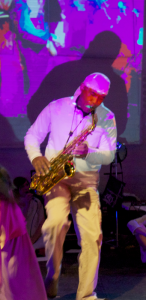
Strickland has performed internationally; been featured on recordings of Bob Moses, Marty Erlich, Webster Lewis and Brute Force; performed with notable jazz musicians Yusef Lateef, Pharoah Sanders, Herbie Mann, Danilo Perez, Shirley Scott and Marlena Shaw; and has opened for Miles Davis and Sonny Rollins. He had leading roles in Boston Art Group, Northeastern University productions, and Vineyard Playhouse Productions, has performed and collaborated with choreographers including Alvin Ailey, José Limón and Bill T. Jones.
He was profiled/featured along with Blair Underwood and Lamar Burton in the documentary film Black Man Up, performed at the Sundance Film Festival, at three fashion/fragrance events for fashion designer Donna Karan and at Solstice Sing For Peace.
Strickland has a M.A. degree in Expressive Arts Therapy from Lesley College, where he is an adjunct professor, and also teaches at Berklee College of Music, Tufts University, and Longy School of Music. He is co-executive Director of “Express Yourself”, working in partnership with adolescents in public mental health residential facilities to produce multimedia performances.
Awards
Stan received the Martin Luther King Music Achievement Award from the city of Boston in 1991, The Cambridge Favorite Musician Award in 1994, and an award for Exemplary Service to the mentally ill from the Massachusetts State House in 1996.[1]
Discography
Stan’s jazz vocal CD released by Hawkline Records in 2005, Love & Beauty, features new arrangements of jazz classics as well as original material. He has also been featured on three tracks as a saxophonist and vocalist on Laszlo Gardony‘s 2011 CD, “Signature Time” (Sunnyside) as well as on Laszlo Gardony‘s 2015 CD, “Life In Real Time” (Sunnyside) as saxophonist and bass clarinetist.
ESCAPE – 9.28.2017
Tabula Rasa Multidisciplinary Experiment returned to Warehouse XI on September 28, 2017.
Russ Gershon (sax, of Either/Orchestra & Lookie Lookie), joined us, as did Syd Smart, Chien Hwe (dance, 1000Virtues), Stan Strickland (voice, alto sax, flute), Andreas Agiorgitis (tango), Josh Rosen (piano, ZiggleZaggle music), Werner Grundl (video), Julie O’Neil (photography), Callie Chapman (dance, Zoë Dance, Studio@550), Giuseppe Paradiso (drums), Stephen Petrilli (lighting), John Voigt (bass, spoken word), Tamar Etingen (live art), and Catherine Musinsky (dance).
The second half of the show was lit up by a 5 year old girl named Faith who joined the dancers onstage, along with Catherine’s 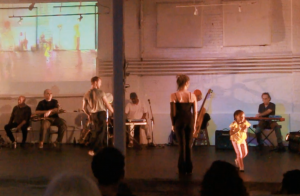 mother, Bonny Musinsky, 84. The music was stunning as always, and the painting by Tamar Etingen was fantastic to watch unfold with the performance.
mother, Bonny Musinsky, 84. The music was stunning as always, and the painting by Tamar Etingen was fantastic to watch unfold with the performance.
I’ll post some video as soon as it’s ready.
Supported by the Somerville Arts Council and Warehouse XI, Tabula Rasa is an open experiment in improvisational performance at a spacious and welcoming warehouse in Union Square, Somerville. A recently converted warehouse, Warehouse XI has a rough hewn quality and sheer size make creative minds go wild. It is located right behind Journeyman restaurant in the alley between the Independent and Bronwyn’s restaurants in Union Square, Somerville.
Photos from Apocalypso!
TRANSPARENT – April 8, 2017
This past April the great RUSS GERSHON, of Either/Orchestra and Lookie Lookie joined us for the first time; along with revered Boston percussionist Syd Smart; limpid dancer Chien Hwe; power mover Emily Jerant-Hendrickson; drumming wiz from Italy via Berkeley, Giuseppe Paradiso; and lucky to have had the amazing lighting designer, Todd Sargent. The glorious singer, Gabriela Martina, joined us; as did the exquisite dance phenom and ZoeDance director, Callie Chapman; and floutist extraordinaire Matt Samolis! I forgot to mention in the credits the awesome Scott Getchell, who played flugelhorn that squealed in opening of the video above. Josh Rosen, the incredible jazz composer and keyboardist joined us, as did the dancer/poet/professor, Karen Klein, and finally, Catherine Musinsky, Tabula Rasa producer and director, danced, directed, and projected filters for Werner Grundl and Julie O’Neil‘s live video.
Werner posted the full video of the first half here and the second half here.
No one regretted coming.
Origins and dreams
Tabula Rasa Multidisciplinary Experiment started as a celebration of a new event space opening up in Union Square, now called Warehouse XI. The project has since taken on a life of its own, as it fulfills a need, as expressed by many artists who have taken part, to work across the usual boundaries that divide the performing arts.
The improvisational and cross-disciplinary aspects of Tabula Rasa Multidisciplinary Experiments reflect interests that have emerged in me over many years as a performing artist. As a dance performer I missed the electricity of live music when dancing to recorded music. I always looked to the visual arts for inspiration, and have an amateur painting practice of my own. I have delved into video production, 2- and 3D animation, music, theater and other art forms, finding the disciplines draw important lessons and inspirations from one other. Improvisation has also become my favorite mode of performance, in part because of the difficulty of holding on to choreographic inspirations. I found it hard to trap movements inside repeatable phrases in a way that preserved the quality of the original improvisational research. I also felt choreography lacked the excitement of improvised movement, both in doing and watching. Structuring improvisations provides a compromise between overdetermining choreographic movement on the one hand and undisciplined, random movement for movement’ssake on the other.
A typical Tabula Rasa performance “experiment” invites audiences into the warehouse as finishing touches are made to the stage, so as not to hide any aspect of the process. Todd Sargent, the lighting designer, may focus a few lights, dancers and musicians warm up, and the artist sets up her onstage canvas and paints. When everyone has settled, the stage lights come on and the performance begins. We dance with and without planned structures, the musicians both follow and lead the dancers, and the artist paints the scene. A videographer shoots from a camera whose signal is fed into a computer program that filters and alters the video in various ways: delaying, thresholding, recoloring, cartooning or layering it, and then a projector shines the result on the wall over the action. The first half of the show unfolds. After a brief intermission, artists in the audience are invited to participate in the second half. Visual artists in the audience are provided tables and water with which to paint, and photographers and videographers have the freedom to roam.
Tabula Rasa Multidisciplinary Experiment has attracted artists and audiences with a keen interest in cross-discipline improvisation. I am pleased to have provided them and myself with the place and premise of Tabula Rasa. I still find myself searching for ways to rein the chaos that occasionally results when ten artists in a space each listens to his or her own muse. In 2017 my goal for Tabula Rasa Multidisciplinary Experiment is to continue the quest for the delicate balance between structure and spontaneity.
APOCALYPSO! January 14, 2017
On Saturday 1/14/2013 at 8pm Tabula Rasa Multidisciplinary Experiment presented APOCALYPSO!
We filled our cups before inauguration.
Boston’s finest Jazz and World musicians (Stan Strickland, Syd Smart, Bob Toade, Gabriela Martina, Scott Getchell, and Jason McCool), dancers (Callie Chapman, Catherine Musinsky, Aaron Brando, Chien Hwe, and Callie Chapman), artists (Tamar Etingen), and poets (Karen Klein, Julie Ann Otis and Daniel Kinsey) journeyed through a transcendent evening where sound, cadence, composition, rhythm, movement, poetry, and one another were all that mattered. It was a a beautifully lit night of improvisatory performance, and some of the audience joined in the second half.
A party followed as we ate delicious split pea soup to Stan’s dulcet tones.
Thanks, Somerville Arts Council and Warehouse XI, for your generous support!
WAREHOUSE XI:
11 Sanborn Ct., Union Square, Somerville, MA 02143.
Unbelievable
Post election, everything seems to have shifted. On retrospect we look naïve. Whatever was happening was not what we thought, but the stage was set for this moment. Whatever you believe was the cause, it was already in motion.
Maybe that’s one reason it feels like a betrayal. As all the times you thought your love was at a meeting but he or she was with someone else, so all the times we thought our girl was winning, the sleazy guy was grabbing her from behind.
What do we do now? Hail Mary. Subpoena the election boards for paper ballots and installation cards. Petition the electors to vote their conscience.
Then sing to drown out the lies, dance to move out the demons, paint to show each other gratitude. Let’s prepare a show for the second weekend in January.
